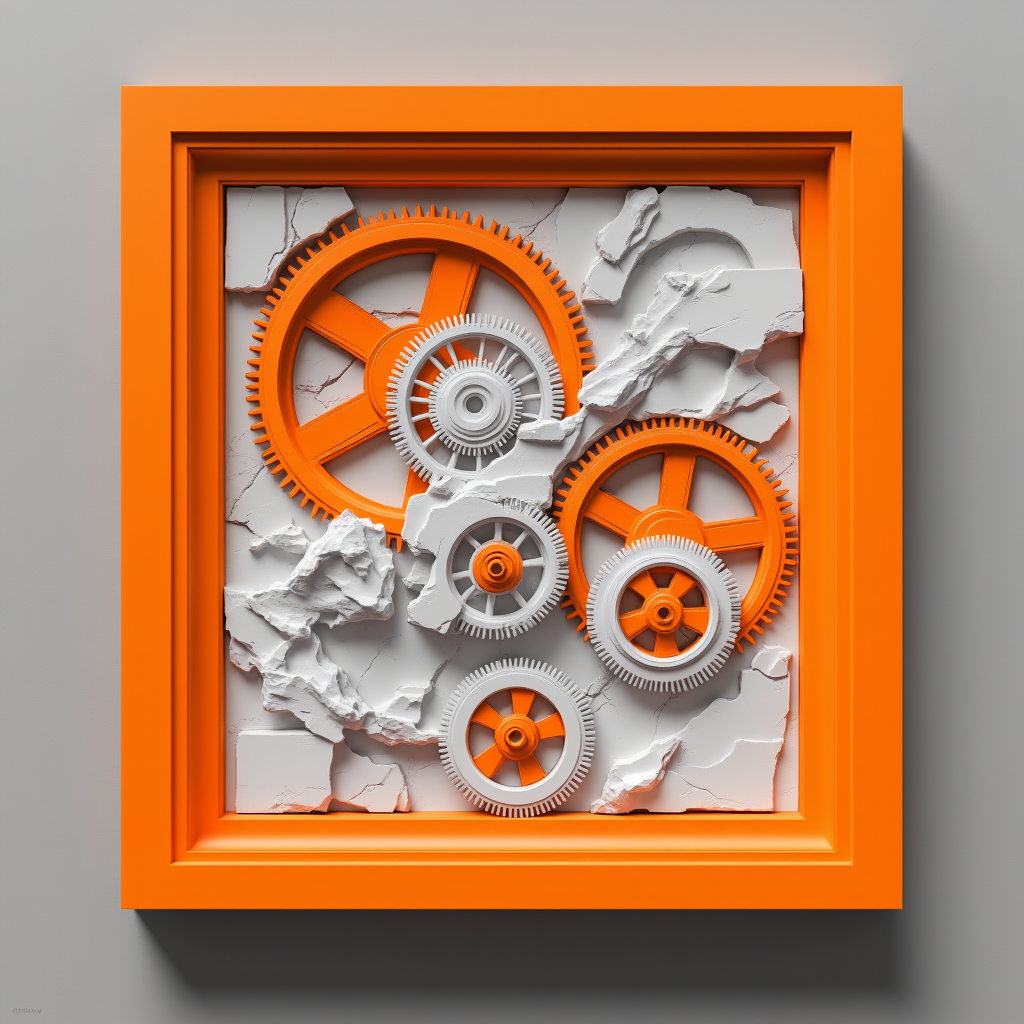Introduction: The process expert versus the rise of the machines
Andrzej Kinastowski (AK): Konnichiwa! Welcome everyone to the Office Samurai podcast. That show that looks at the modern workplace and asks seriously this is the future they promised us. Today’s topic the process improvement expert versus the rise of the machines. We’re looking at those masters of efficiency the lean practitioners, the business analysts, the improvement champions and ask what’s their place when every CEO is shouting AI like it’s the only word they know. I’ll be talking to one of those unsung heroes who used to roam the office corridors clipboard in hand and a stack of post-it notes in the other but now now we have AI that can supposedly automate your process before you’ve even finished your morning coffee. So we’ll be asking are process experts going the way of the fax machine destined for a dusty museum exhibit labeled things humans used to do? Or is all this automation just creating new kinds of messes that only a highly trained human can untangle?
I’m your host Andrzej Kinastowski one of the founders of Office Samurai the company that dares to ask “What if we did business consulting without all the bullshit?”. So whether you’re a process guru wondering if your value stream map now needs an API endpoint, a manager wondering if you can replace your entire team with a chatbot or just someone trying to figure out if yelling at your smart speaker counts as process optimization, you’ve come to the right place. Now grab your favorite katana or just a really strong cup of coffee and let’s get to it.
Host and expert introductions
Andrzej Kinastowski (AK): Before starting Office Samurai I have actually made my career in the corporate environment in process excellence. I have started in Capgemini where I’ve been studying Six Sigma and Lean Management and running projects and programs, then went to UBS to do it there, although to be fair an investment bank at the time was not the easiest place to change things. And then I moved to Lufthansa and there I was running a global continuous improvement program for the Shared Service organization. And so I have moved towards the automation world but process excellence has a really warm place in my heart and I am still doing this kind of consulting and projects and trainings. Today this is what we want to talk about. Today we want to talk about how does process excellence fit into today’s world that is focused on automation so much. With me in the studio I have Zuzanna Pamuła.
Zuzanna Pamula (ZP): Hi Andrzej. Thank you for inviting me.
(AK): We have met probably 12 or 13 years ago the first time, and during that period we have done a lot of interesting things together. You are very deep into the process excellence world so a Lean practitioner, a Six Sigma Black Belt. You host and speak at conferences and we have together and together with other people we have started a service process improvement network association. Could you tell the listeners about your experience and why you are the person that I’m talking to about process excellence?
(ZP): Thanks for this introduction. To add to my experience I would say that I had worked for shared service organizations GBS’s for 12 years. I’ve started in UBS where we met, then I moved to Heineken and Lundbeck. In those three organizations I used to work as a continuous improvement specialist expert responsible for maintaining developing continuous improvement cultures, engaging people employees and managers towards the improvement efforts, solving problems, leading workshops and process analysis trainings. So answering your question why I am here, I think that I’ve seen a lot in those organizations about processes about process excellence. Now in Office Samurai I work as a process transformation manager. I’m responsible for a team of business analysts where we support our RPA and AI developers in developing in preparing automation solutions. So I think that in my role I combine in a way two of those worlds. Process in a standard process analysis in the standard understanding of process mapping, process measurements but also the new tools and methods deriving from GenAI.
The process expert role shift in the AI era
(AK): With so much buzz around automation and AI a lot of companies get kind of blinded and only going into AI we have to do AI. When people say that AI is going to take over everything and we will no longer need process improvement expert, what’s your gut feeling? What’s your reaction?
(ZP): So my first reaction and my gut feeling will be same as every other person some uncertainty some fear but I think this is very humanlike reaction and with such a fast development of those technologies we cannot be really sure what’s ahead of us. And it applies to many different jobs starting from those very simple or manual to also those creative ones and requiring lots of brain work. So I think in this process experts business analyst roles there’s also some component of that work that will be done realized by the technology and people no longer will be needed in a way to perform those tasks such as process measurement, process modeling. But I think that not everything and the major component of those roles such as experience, such as understanding of some nuances will be still will be still needed to be performed by experienced business analysts.
(AK): The same thing I remember happening something like eight nine years ago when Robotic Process Automation was so overhyped and people were saying on conferences and consultants were saying “yeah we’re going to automate everything we’re not going to need process experts because all of the processes will be automated”. A lot of years have passed that’s not really what happened. So it probably is going to be like that but I do think that this role because of the rise of automation has changed. I mean when I think about what we have been doing with Lean Management projects those 12 or 13 years ago and what is the main role of a process excellence expert now the balance has shifted. I mean the methodologies stayed the same. Maybe we have some new tools and ideas but we do things a little bit differently and we do them with a different balance of things.
(ZP): Yeah especially faster. When we wanted to perform some process measurement we spent days and weeks sitting next to a person with a stopwatch. I remember that was not the most exciting thing.
(AK): No it was not everyone was frustrated.
(ZP): So it was lots of manual work and then capturing it, putting into Excel, analyzing. And now we have technologies we have software that does it in the background. And our role is then to look at those insights and drive some actions out of it like suggest ways of working whether this is a case for process standardization, RPA, etc. So we are able to perform more of those projects measurements in the same period of time.
(AK): Yeah and this is something. I do remember that measuring a manufacturing process is way easier because it’s very physical you can see what’s happening. When somebody’s working on a computer you need to look at the screen very carefully and ask them because they can be doing a lot of different things with the same tools with the same transactions. And I do remember how much time and effort we spent measuring like you said kind of looking over somebody’s shoulder with a stopwatch which was annoying to people. And on the other hand we had those tools that we tried to use so that people can self measure. But that was also quite annoying to people because they had to remember about this and they felt like it’s just another thing they have to do. And we’ve been doing those things because you need to measure a process to be able to analyze it properly. And this part can be now done with tools. So as you said we can focus on the analysis part and the part that is really humanlike.

How process mining automates measurement
(AK): Could you like briefly I’m sure we’re going to have another episode about those tools specifically but could you like briefly explain what are those tools doing today? How are they helping us to automate this part of gathering the measurements?
(ZP): So for example in Office Samurai we work with one provider of the productivity mining tool technology. And this tool works in a way it reads activities, reads screens that are active actively used by an employee by a user and registers there’s times within those screens. So for example when you perform a process that requires using some ERP program like SAP or something, then you switch to Excel to calculate something, then you switch to another Excel to copy the data or perform some other calculations. You use Outlook, Teams, etc.. Those types of tools read all those screens that you are using, apply some AI of course technology to understand what is actually being done and with a help of business analyst, so this human factor is here crucial. You can map those steps to an actual process and see the processing times. See variance of the process, compare it to some set standard. Then see some patterns, trends, whether people are jumping from one application to another, copy paste activities.
(AK): Yeah the copy paste chart is my favorite. That’s absolutely spot on.
(ZP): So lots of insights about people work and how they work like their work patterns. You can read people’s working hours, how many breaks do they have, how long, how often. But also all those applications that are used actively and productively versus nonproductively in their processes. And you have like measurements that are very very detailed like up to 1 second. Those types of tools productivity mining in business analyst roles help us to identify processes for standardization, processes for some improvements like elimination of unnecessary steps etc.. Compare how different employees are realizing the same process so whether there is a case for cross training, best practice use, etc.. Then process automations, so whether with RPA or with some AI solutions like Copilot. And the other Lean-like insights that you can get from it are like process distributions, workload, and workload balancing etc.. So lots and lots of things that are almost effortless. No engagement needed from the user perspective. Some input from business analyst to actually map the process towards the standard but then unlimited opportunities.
(AK): Yeah and very scalable right? This is something that when you’re doing it manually there’s always a problem of scaling it up. But this is kind of what happens what seems to be happening with AI in business processes in general is that those tools they do not seem to replace humans end to end. They do the heavy lifting, the repetitive stuff, the simple stuff. So then we can focus on the things where you really need a business analyst or a process improvement expert.
The human factor: Domain expertise and network reaction
(AK): When it comes to other people who are in process improvement and I know you have a big network of people who do that what’s their reaction like? Do you see them when they see all those AI tools and automation technologies do they roll their eyes or do they go into it because they see that yeah that’s it seems like this is what we’re doing now?
(ZP): They are super excited. I was also like wondering what would it bring us what would be the moods in the industry let’s say. But people are super excited, super curious and really eager to try those new tools those new technologies and to benefit from them in the daily work. So in my network for example in the SPIN association we are discussing and sharing a lot those news and curiosities about those tools.
(AK): Okay so we don’t go into denial. No we lean to it. Okay it’s good. So you talked about technology that helps us find automation potential. Apart from technology the tool the the skills that process improvement experts have are there are they used to find automation potential too?
(ZP): Yes of course. That’s my experience with that that process improvement experts specialists derive a lot from their experiences whether they are process experiences like someone used to be an accountant in the past. So that person has a really like unique insights into the things that we are looking at and analyzing. For example my colleague from Office Samurai he for many years he used to work as an accountant both in GBS then in small company. I love to take him to every project related with financial processes because his experience is really adding value to the analysis. And myself not having like hands-on experience in finance I’ve never worked in AP team or any other. I have analyzed and worked with many financial teams and processes. I have one set of experiences and patterns that I would like to look for and analyze. But his his input is on a completely different level. It’s a great value to have those experiences and actually it’s a good thing to have those mix of different experiences in a process improvement business analyst teams.
(AK): Yeah this is something I often see too. I used to work in finance. I did some accounting not an accountant but I did some shared service kind of accounting. And we go to the accounting team and somehow we seem to communicate on a completely different level. They can speak in those little magical accounting terms and so on and we get it. That that helps for sure.
(ZP): What you just said when I come to the completely new area that I haven’t touched before I can work with them. Because those process improvement skills are very like universal and you can apply to anywhere. But then I need to learn this jargon, ask stupid questions like what this is what does it mean etc. And the person that has some experience already in the area can communicate easier and also gain this kind of trust from those people that he understands us. She knows what we are doing. She knows what she needs from us.

The evolution of the CI toolbox
(AK): Apart from process mining the toolbox of a process excellence expert has it evolved over I don’t know the last 10 years? Meaning like we used to go around the office with flip charts and sticky notes and a lot of markers. Has this changed? Do we have any new tools or is this the same game?
(ZP): I also walk around with with postits and flip charts. For example next month I will be having workshops in one of our clients and yeah I require them to prepare a room with a big whiteboard or wall old school.
(AK): Very nice. Old school.
(ZP): For some of the activities the old school method is still the best one you can apply and the most fun. Also engaging, right? I think that all people that facilitate some kind of trainings or workshops online struggle at some point with engaging participants online without like direct direct contact. And so old school methods are still fine and I think that there will be it will be years until we we will replace them like completely with with the new stuff.
But the new tools that we use can save us a lot of time and save the time for us so process improvement people. So we are also benefiting from those tools and removing those wasteful activities from our our daily work. So for example Copilot toolbox. And for example lots of companies work in the Microsoft suit. So all of those new apps and tools within it they are very cool to work with and lots of team engagement, workshops facilitation, some analysis can be done with less less effort and more fun than than it was before.
(AK): Sure. Copilot I mean it’s still a bit rough around the edges but there are some aspects of Copilot like the moment I saw Copilot in Teams I knew that this is my new favorite tool. When you can make a transcript of a meeting and then just the fact that it can create meeting minutes for you because everybody hates writing meeting minutes and thank you Microsoft I am grateful. I always hated doing that. And now it does it for me. They’re not always perfect but it takes me 2 minutes instead of 20 to to prepare them. Do you see this kind of tools having more and more impact on what we’re doing? What exactly are your people doing right now? How are they using this kind of technologies right now? And then what do you think would be the next steps?
(ZP): So you mentioned Teams. So this is also one of one of my favorites meeting minutes but also this coach speaker. Very nice when you like when you are like working on your presentation skills for example. When it comes to day-to-day work of process improvement person or just any other person working in business, Copilot in Outlook helps you a lot in creating messages. Also so much less effort in putting together emails into analyzing long email thread. Adjusting the tone of the message, make it more formal, less formal etc.. This is helping me a lot and I think this is a very good tool to be used in any process on any position that saves minutes. In process improvement in Lean we say like every minute counts. Same with Copilot used for Excel for PowerPoints. These are as you said rough on the edges but I can see it evolves. Every time I work with it I can see there are some some tweaks and tricks that that are really like cool and useful. And these are also good to have in your toolkit day-to-day work. For example in Excel it advises you “maybe you will add this column to calculate this and that”. “Maybe this insight is interesting for you” or another insight. So this is nice. And actually a few weeks ago I had this retrospective meeting about one of the projects we took part in with my team. So we used whiteboard within Teams had this brainstorming using those posted shapes and we asked Copilot to organize it for us and then summarize drive some actions. Very cool stuff.
(AK): I didn’t know it can do that. I I need to give it a try. Okay, that sounds cool. With Excel also the Copilot in Excel is getting better and better and I just saw I didn’t have the time to test it yet but you can switch it into this mode where you can ask it to calculate things for you and it switches to like Python mode or however it’s called. And then you can like dig deep into into the data. It still requires you to know how to analyze data, right? You need to ask the right questions and be able to judge whether the answer makes sense. But again it’s something that speeds things up instead of you calculating things, putting things together. It can do it for you. So you can just use your judgment on the data. So this is one of the things that I think will be quite helpful for us once it gets really good and easy to use especially that there’s a voice mode so you can talk to it like in a science fiction movie with talking to it instead of typing.
(ZP): Okay I haven’t tried it yet.
(AK): You can converse with it. I I I’m not sure it’s going to be efficient but it’s cool. So this kind of things for sure for people like us who do need to be able to understand data and gain insights from this data I’m sure it’s it’s it’s going to be even better. So what are the other ways that AI is helping you and your team in your work?
AI for training and expertise

(ZP): For sure with preparing developing training materials. So you as an experienced trainer for sure you have your ways of delivering trainings you have your scripts you have your materials but sometimes you are in a situation that something new needs to be added, something else prepared. So this is very cool use of AI to ask for examples of I don’t know processes challenges in this given area. And recently I was delivering Green Belt training for one of our customers. And in my previous training materials I really didn’t have good example on risk assessment tool FMEA. I asked I had limited time it was like last evening before the training started. I asked the AI could you prepare this kind of exercise for me to practice FMEA tool? Of course I prompted it correctly given this background etc.. So it created for me a script for participants for the for the exercise. It created for me template as a handout for participants, example solution of the case study. It suggested in the script and actually I did no corrections on it. This one was like perfect from the beginning to to the end. I had another exercise with process mapping. So the output was yeah questionable. But you know the the the formula the script for participants was after some some finetuning it was it was okay but this FMEA exercise I was really surprised myself. So I think that this is one of the good uses of AI for trainers. To help with training materials like inventing new examples new use cases.
(AK): Yeah. I think I would probably do the same thing because I’m not a huge fan of FMEA. So I would probably use GenAI to to help me with that. But it is also my experience that for preparing trainings it can help you a lot. You need to understand the thing that you’re training on and you need to have the skills to deliver it. But to come up with examples with exercises that that can help us a lot and it can unbburden us from having to prepare those especially as you said if you need examples tailored to a specific industry or a process.
(ZP): Or translating.
(AK): Even or translating. That translation of materials has always been a chore. So that that has gotten way way better with GenAI coming into play. One thing you mentioned and I think this is important for us to really strengthen this message is that when you are a business analyst some part of your job will be performed by new technologies new tools but you need to ask it the right questions, right? Because the AI tools that we have right now can do wonderful stuff for us provided they are correctly like prompted, right?
(ZP): So prompting and putting your expertise your human judgment into what it produces for us. Especially when you have this longer conversation and the AI tools tends to stick with their original assumptions. As humans we we think more broadly holistically I think and we need to sometimes like adjust the course of this of this analysis for example.
(AK): No I I think it’s a good point. Those are amazing technologies they are really cool and and we are really eager to use them but we have to remember that one thing is you still need to learn how to use them properly, right? And the other thing is you still need to use human judgment because sometimes they make mistakes sometimes they hallucinate. And there’s a lot of stories around where somebody just takes an answer from a ChatGPT and then gets fired because it was not a great answer. So yeah that that it’s it’s really important to learn how to use those tools properly not just start using them right away. Something we actually discussed some time ago is we can see in Office Samurai that some companies seem to be kind of circling back to continuous improvement because there was a time when everybody stopped ordering continuous improvement trainings, continuous improvement projects. Everybody wanted to do automation and now we seem to see that some companies are coming back to it. You are delivering a lot of those trainings, right? What do you think is happening here? Do you have a theory of why why it’s like this?
(ZP): So I think that companies realized that first of all automation will not solve all the problems. It will speed up the work yes. But if there are some problems issues with input quality wherever in the process automation will work with it as it is. So in my opinion companies started to to realize that automation is not answer for everything and we work we need to work with the processes to make them as good as possible and only then automation makes sense. This is you can site Peter Drucker or someone to not to automate waste. But I think that management of big institutions big organizations realized it in the last years that RPA or automation any kind is not is not solving their all of their problems. So I think this is this is it and also the need for standardization harmonization this is this should be the first step before automation, right? To first create a standard the best possible method to realize a process to harmonize it across I don’t know regions customers etc. and then apply automation to have one common automation instead of 15 for 15 European countries.
(AK): Yeah that would be a perfect scenario. I mean of course we’re talking the best achievable version of the process, right? We cannot wait till everything’s perfect because then we’re never going to automate anything. But I do agree that most of the time companies probably try to automate processes too early without cleaning them up. And then it’s doable, yeah, but it takes a lot more work and then you just have a lot of automated waste. Automated waste is better than non-automated waste. But nevertheless if somebody is thinking about starting a career as a process excellence specialist they want to start now what would be your advice? What do you think they should be doing or focusing on to to get into it?
(ZP): I think my answer will be the same as I would give it like five or 10 years ago to someone: to just start doing it. To go to your process or to any process that you are like close to, look at it and think how it can be done differently. So when you are working already in any company think about the process that is most time consuming, frustrating, generating issues and think what what you can do with it. Read things on Lean and all those improvement methods, watch YouTube videos or a podcast like this one. Ask ChatGPT about that stuff. Inspire on how to do that and just change the process if you have the mandate. If you don’t work anywhere yet, observe the world around you. How would you improve this I don’t know doctor’s office or this cafeteria you go to. So start thinking about processes in a way that from a perspective of for example this business owner. How could how would he she would like to this process to operate? What would be the best version of this process? Look for process improvement people in your organization. I would say some practice on your area of work responsibility. And then when you know what this is like you have some ideas it’s good to learn from some smart people. So read something watch something.
(AK): Do you think robots or automations or AI will eventually do better process maps than you or do you think you’re safe?
(ZP): Hope not :). No, I’m just kidding. So right now they are not not there yet. No to be honest I hope yes why not? If those technologies would be able to do that I would love to use them to reduce the workload of myself that is not required for me to perform. I think that’s the mindset. Creating process maps is a rather manual work, right? Of course it requires lots of experience, some expertise, knowledge of those BPMN shapes etc. but this can be done by new technologies and I I think most of the business analysts will be really glad to hand it over.

Final message to executives
(AK): Okay sounds good. If you could send one message to all the executives of the world that are rushing to go into AI and disregarding everything else what message would that be?
(ZP): I think it will be something like AI will solve many of your problems and will bring lots of efficiencies to the business. But you cannot forget about critical thinking. You cannot forget about some experience of people, people’s capabilities of identifying those opportunities in the processes solving those problems. So even AI needs to be again asked properly, prompted properly. So it needs to be human input to to the tool that will solve many problems and challenges of your company. So do not forget about people and again do not automate waste, do not automate parts of the process or the processes that are not bringing value to the customer, processes that are full of unnecessary activities unnecessary steps.
(AK): So I guess the message to the executives is AI is fine but you still need us. Good. Okay I do hope you all got some good information on what is the role of process excellence experts in the today’s world of automation and AI. Thank you Suza for joining me and thank you for sharing your insights and experience with everyone.
(ZP): Thank you for having me. It was a pleasure.
(AK): And that is the final process step for this episode of the Office Samurai podcast. Domo Arigato to all you listeners out there. Whether you were nodding along sagely or frantically updating your LinkedIn skills section during this episode we appreciate you tuning in. Massive thanks to my guest Zuzanna Pamuła for sharing her insights from the front lines of the process with us. And as always a salute to Anna Cubal our producer who masterfully adapts to my unpredictable processes week after week. We recorded at Wodzu Beats Studio our dojo for trying to make sense of it all one podcast at a time. If this episode sparkled joy or maybe just a healthy existential dread about your job security please subscribe leave a review or tell a friend who might also be wondering whether their flowchart skills are still relevant. Until next time don’t trust any process map generated too quickly. Mata ne.




